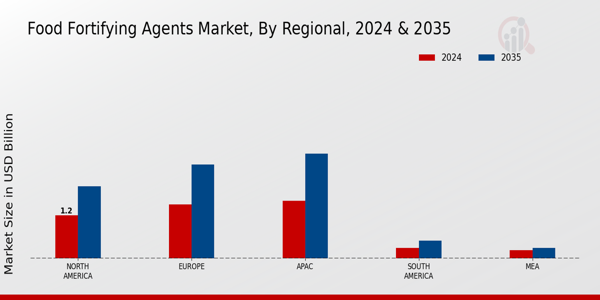Rising Nutritional Deficiencies
The Global Food Fortifying Agents Market Industry is driven by the increasing prevalence of nutritional deficiencies across various populations. For instance, the World Health Organization reports that deficiencies in essential vitamins and minerals, such as iron and vitamin A, affect millions globally. This has led to a heightened demand for fortified foods, as consumers seek products that can help mitigate these deficiencies. The market is projected to reach 4.83 USD Billion in 2024, indicating a robust growth trajectory as manufacturers respond to consumer needs for enhanced nutritional profiles in food products.
Globalization of Food Supply Chains
The globalization of food supply chains is influencing the Global Food Fortifying Agents Market Industry by facilitating the distribution of fortified products across borders. As international trade increases, fortified foods become more accessible to diverse populations, particularly in developing regions where nutritional deficiencies are prevalent. This trend is likely to enhance market penetration and stimulate demand for fortifying agents. The interconnectedness of global markets suggests that as fortified products gain traction in various countries, the overall market is poised for substantial growth.
Consumer Awareness and Health Trends
Increasing consumer awareness regarding health and nutrition is a significant driver of the Global Food Fortifying Agents Market Industry. As individuals become more health-conscious, there is a growing preference for fortified foods that offer additional health benefits. This trend is reflected in the rising sales of fortified products, such as cereals and dairy items, which are perceived as healthier choices. The market's growth is further supported by the anticipated compound annual growth rate of 4.93% from 2025 to 2035, as consumers increasingly seek products that align with their health goals.
Government Initiatives and Regulations
Government initiatives play a pivotal role in shaping the Global Food Fortifying Agents Market Industry. Numerous countries have implemented mandatory fortification programs to combat malnutrition and improve public health. For example, several nations have mandated the fortification of flour with iron and folic acid to reduce anemia rates. These regulatory frameworks not only encourage the adoption of fortifying agents but also create a conducive environment for market growth. As a result, the industry is expected to expand significantly, with projections indicating a market size of 8.2 USD Billion by 2035.
Technological Advancements in Fortification
Technological advancements in food processing and fortification techniques are enhancing the Global Food Fortifying Agents Market Industry. Innovations such as microencapsulation and improved delivery systems for vitamins and minerals allow for more effective fortification without compromising the sensory attributes of food products. These advancements not only improve the efficacy of fortifying agents but also expand the range of products that can be fortified. As a result, manufacturers are likely to invest in research and development, further driving market growth and diversification.




















